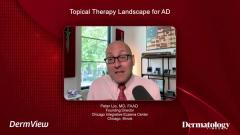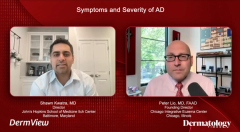
Body Surface Area and AD
Peter Lio, MD, FAAD, discusses how body surface area of atopic dermatitis (AD) affects topical treatment options.
Episodes in this series

Transcript
Shawn Kwatra, MD: When we talk about these therapies, specifically topical JAK [Janus kinase] inhibitor vs a biologic, or an oral JAK inhibitor, the question is, how much emphasis do you put on moderate to high level of body surface area? Are there times that you’ve been surprised with how topical may affect a greater body surface area or kind of real-world utilization because as we’ve seen from psoriasis, it’s very interesting. The minimum amount of psoriasis that has led to biologic use seems to have been going down over time. What I’m seeing and predicting is that in atopic dermatitis, we’re seeing a little bit of a lowering of that threshold to it. Now, you see some clinical trials. I saw some data on dupilumab for hand eczema. Situations where you normally may think, let’s do a topical steroid like clobetasol, or a topical, do you have any thoughts on this kind of trend, and what are your personal beliefs?
Peter Lio, MD, FAAD: Yes, I love this idea of the treat to target and with psoriasis, we’ve seen that target just get more and more and more stringent. It used to be like, “We’re going to try to get you a little bit better once in a while” and now it’s like, “I want you to be almost clear all of the time” without “It’s amazing,” but only because we’re empowered to do. We have the tools, right? We can do it because we have the tools, but in the old days, it was the same thing with atopic dermatitis. Why would we jump to a biologic for limited or localized disease? Ideally, and I believe that it’s good faith, it’s because they’ve tried and failed at the first few things. They’ve tried their topical steroids and they’re not there. To me, it’s an easy calculation if you’re with dermic. I mean, you’re not going to be able to get enough topicals for most people to do the whole job at some point, you just become cumbersome. Maybe, in the short term, you could hospitalize the patient, but once you get a little beyond it, it’s not viable. Of course, the second part is to think about refractory disease, even if it’s less than a certain point. Many people say that maybe 20% body surface area, once you’re much beyond that and topicals alone becomes more of a challenge. With little kids, we can get by with what we can kind of coat them in something from head to toe. That’s easier. But for adults, if you have more than 20%, about extreme stereotypical plus, some of our options are limited. For example, with ruxolitinib, you aren’t supposed to use it and more than that, you have kind of a hard stop in terms of absorption. Then, our other friends, like our insurance company buddies, often will not pay for anything beyond topical steroids and enough quantity; as we say, our 454 grams of triamcinolone is a signature move, but only in part because we know that we can get it. Good luck trying to get 150 grams of your ruxolitinib or something like that per month, if you needed it.
Shawn Kwatra, MD: Absolutely.
Transcript edited for clarity.
Newsletter
Like what you’re reading? Subscribe to Dermatology Times for weekly updates on therapies, innovations, and real-world practice tips.


























